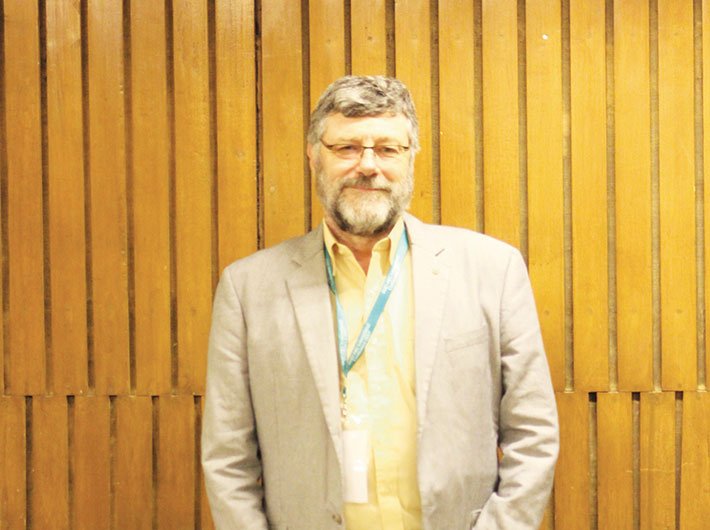Professor Peter Sly, from the University of Queensland, Australia, who is the co-author of the Lancet report on pollution talks about the grave consequences of the toxic air we breathe
At a time (Mid-November) when the national capital was engulfed in thick smog, public health experts from Australia, United Kingdom, Canada and other parts of the globe were in Delhi to attend the annual meeting of the Pacific Basin Consortium for Health and Environment. The meeting was held in India for the first time in 17 years. Scientists, researchers and policymakers thought it was the right time to ring the alarm bells for the countries affected by severe pollution by discussing the findings of the latest Lancet Commission report on pollution and health. Professor Peter Sly, from the University of Queensland, Australia, who is also the co-author of the Lancet report and director of the consortium, talks about the grave consequences of pollution not only in the form of lung infections but also behavioural changes and premature deaths.
Delhi is going through a health crisis. Air pollution has crossed the danger mark and particulate matter has enveloped the city in thick smog. What is your analysis of the situation?
I arrived in Delhi in the early hours of Saturday [November 11]. When the plane was coming down the first thing we do is smell the air. By the time we got down, we could closely see the air. I have been to Delhi before and I know it is that time of the year when air pollution is a problem but I haven’t seen it this bad before. This is my sixth or seventh visit to India. Delhi has gone through some interesting phases. Delhi banned diesel buses and got clean air. It was really interesting to see how the policy people of that time were strong. They saw the solution and the air [quality] improved. Now, they have a problem because they seem to be paralysed.
The entire debate is around vehicular pollution and stubble burning. Are these the only two factors?
There is something more to it. This time of the year, Delhi has a problem: there’s no rain and very little wind. Even when the monsoon comes, the air is not fantastically good. So these are the conditions which allow the pollution to build up. If you are controlling stubble burning and traffic pollution for this part of the year then you should control [them] for all of the year. Nothing happens unless there is an emergency. It’s fine if you get an action plan for an emergency but you also need an action plan to prevent it from getting into this stage. It is a round-the-year problem, especially for health and the growth of children in particular. It was disappointing to see reports [on Lancet Commission Report] in newspapers where officials said that it is not an Indian data and it does not apply to them. This is just very naïve and wrong.
The Lancet Commission Report states that deaths due to all forms of pollution show a peak among children younger than five years of age. How serious is it in India?
The major message from the Lancet Commission was that pollution in its broader sense kills more people than infectious diseases, violent crimes and traffic accidents. It is estimated in 2015 to be responsible for nine million excess deaths globally. From that point, it is a very dangerous situation for not only Delhi alone, but India. We know that this level of pollution will have an effect on the ways babies are born, the way their lungs grow and function. It will make them more susceptible to respiratory infections and diseases like asthma and in the long term to chronic respiratory diseases as they grow. The situation will not affect people only for three or four weeks. The children are going to be living with the consequences of this pollution for a long time. Certainly, one instance doesn’t cause a disaster; but it is being constantly repeated.
What trends do you see in India when it comes to effects of air pollution on health?
I will go back to a different situation in Australia, in Brisbane, where I live. We don’t have a substantial problem with air pollution; levels are lower than here. Even there, we can measure the effects of air pollution on babies’ growth and on risk for respiratory infections and lung functions. It is a problem that can be solved and the best example of action leading to improved health is in southern California. Through regulations they have decreased the pollution levels over the last 10 years and have shown an increase in the health of children and fewer admissions in hospitals for respiratory diseases.
Now, there is nothing special about Americans or Australians. While there are ethnic differences, the susceptibility to air pollution is everywhere. We know the air pollution here had health consequences. In the long term, you can predict what changes you can see in the lung functions of children after repeated exposure to pollution.
Are you saying the in last one or two decades we have seen a direct impact of the air pollution on the lung functioning of children?
Yes. But we don’t have data in India. The reason we don’t have data in India is because this has not been a major focus. It is not easy to measure lung functions in babies and children. It is possible but not easy. There are no centres in India with expertise in measuring lung functions in babies and school-going children.
Like other nations, how important it is for India to have something like children’s environmental health programme or department you have been advocating?
It is a strange term. Basically what it means is how the environment in which children live influences them. Now, health means more than the absence of disease. A healthy person, apart from not having disease, is growing well, has good education and nutrition. And the environment has a major impact. The reason we concentrate on children is because they are more vulnerable to the affected environment. They are actively growing, so children eat more food, drink more water and breathe more air relative to their size. So whatever is contaminating the environment, they are going to get a bigger dose. Their lungs and brain system are not mature and they are influenced by environmental exposure. This is why exposure to toxic chemicals and pollutants can have major effects on children. It decreases their IQ and also changes their behaviour. I haven’t seen any data showing behavioural problems becoming common in India. They are certainly in other parts of the world.
The Lancet Report talks in detail about the behavioural changes due to pollution.
It is because the brain is not mature and is continuing to grow. Neurons are like wires conducting messages from the brain to the rest of the body. These are like electrical wires and in children these wires are bare. As they grow, there are insulations wrapped around the wire to make the functions of the wire much more efficient, high brain functions and develops intelligence. Pollution affects these insulations. Traffic pollution has shown in Spain that children who go to school via busy roads do less well from the learning point of view than the children who go to school in a less polluted environment. These are the major conditions that affect the life, health and wellbeing of the community. We are limiting our children’s development; the future of our society is limited.
How do you see India’s pollution situation in comparison to its neighbouring countries?
India, Pakistan and Bangladesh all have similar problems. Sri Lanka too has the same problem but they are tackling it a bit differently. They have a very deliberate partnership between the ministry of health and the ministry of environment to tackle issues that cross the boundaries. We have heard that ministries in Sri Lanka are actively working together.
What are the policy issues that are to be addressed urgently?
The biggest policy issue that has to be changed is not to wait for a crisis before you implement some actions. We heard a speaker from the National Green Tribunal. He said that for any development work you have to take permission under the Air Act, Water Act and Environmental Protection Act. But recently that wall was suspended. Building or other construction work no longer requires that permission and this is being suggested as an important step in the ease of doing business. There is no point doing business if you don’t have a healthy population. There has to be an understanding that you can have economic development without pollution. There are new technologies that can be employed to increase development but at the expense of the population. Economic development is important but you can’t have that development that kills the population.
The Lancet Report mentions economic modelling as a solution. Obviously, solutions are different in different countries but the long term consequences of not looking at solutions is loss of productivity, personal and family loss of income, premature death or disability. All over India chronic non-communicable diseases are more responsible for the burden of disease than infectious and communicable. And this is a direct result of changes in lifestyle, changes in pollution, diet and other factors. But pollution is a major part of it. n
archana@governancenow.com
(The interview appears in December 15, 2017 issue)

